Exploring the prescription in rules and mechanism for cerebral infarction based on data mining and Network Pharmacology
Bo Liu,Zi-Xiang Kou
Abstract—Objective:This study intends to explore the prescription rules for cerebral infarction treatment based on the famous prescription book Qian Jin Yao Fang,and further mined the core prescription and predicted the main active components and targets.Methods:The prescriptions for cerebral infarction in "Qian Jin Yao Fang" were collected.The data were analyzed using the auxiliary platform of traditional Chinese medicine V2.5,to explore the core herbs and summarized new prescriptions.At last,we analyzed the mechanism of core prescriptions of for cerebral infarction treatment using network pharmacology methods.Results:100 prescriptions and 152 kinds of herbs were obtained by data mining.The results showed that deficiency-tonifying drugs account for a large proportion of drug classification;The core prescriptions for cerebral infarction in"Qian Jin Yao Fang" were composed of Herba Ephedrae(Mahaung), Cinnamomum cassia Presl(Rougui), Panax ginseng C.A.Meyer(Renshen),Glycyrrhiza uralensis Fisch(Gancao),Saposhnikovia divaricate(Trucz)Schischk(Fangfeng), Aconitum carmichaeli Debx(Fuzi) and Ligusticum chuanxiong Hort(Chuanxiong).Using network-based systems biology analysis,we predicted that 194 potential targets in the core prescriptions for cerebral infarction.45 key targets of the core prescriptions were obtained in the treatment of cerebral infarction,suggesting that the related mechanism maybe closely related to TP53,STAT3,AKT1,MYC,FOS.Through Gene Oncology and Kyoto Encyclopedia of Genes and Genomes analysis,we found that the related signaling pathways mainly involved in PI3K-Akt signal pathway,TNF signal pathway,AGERAGE signal pathway,and so on.Conclusion:It takes expelling wind and relieving surface and warming spleen and kidney as the treatment method of cerebral infarction in "Qian Jin Yao Fang".The core prescriptions were used for cerebral infarction treatment for the multi-component,multi-target and multichannel interaction,such as PI3K-Akt signal pathway,TNF signal pathway,AGE-RAGE signal pathway and so on.
Keywords—“Qian Jin Yao Fang”,cerebral infarction,data mining,network pharmacology
I.BACKGROUND
Qian Jin Yao Fang is an important academic work of Sun Simiao– a famous doctor in Tang Dynasty,which focused on syndrome differentiation of organs and embodied Sun Simiao’s treatment ideas and experience in diagnosis and treatment of various diseases [1].Cerebral infarction is a common disease,which is often characterized by sudden coma,hemiplegia,skewed tongue,aphasia or aphasia,and partial numbness.The incidence of the disease is increasing,and has a younger trend [2].Sun Simiao has rich clinical experience in the treatment of cerebral infarction,which is discussed separately in "Qian Jin Yao Fang" [3].The corresponding prescriptions were searched in "Qian Jin Yao Fang" with the keywords"cerebral infarction","paranoia","speech disadvantage" and"oral malaise".The core prescriptions and drug use rules were excavated using the auxiliary platform of traditional Chinese medicine inheritance,and the disease targets of the core prescriptions were analyzed by network pharmacology,to fully explore the modern pharmacological significance of Sun Simiao in the treatment of cerebral infarction.
II.METHODS
A.Analysis of therapeutic prescription in"Qian JinYao Fang"for cerebral infarction
1) Inclusion and exclusion criteria of prescriptions:The prescriptions about cerebral infarction in "Qian Jin Yao Fang"were collected.The corresponding prescriptions were searched in "Qian Jin Yao Fang" with the keywords "cerebral infarction","paranoia","speech disadvantage" and "oral malaise".Prescriptions with specific drugs,prescriptions with uncertain effects,non-oral prescriptions were excluded.It was finally included in 100 prescriptions.
2) Standardized herbal names:The names of traditional Chinese medicine were standardizedaccordingtotraditional Chinese Medicine[4] andthe GreatDictionaryoftraditionalChinese Medicine[5].
3) Prescription input and processing:They were successively imported into Excel 2016 and "Chinese Medicine inheritance Auxiliary platform V2.5" after sorting out all the prescriptions.Two researchers reviewed respectively to ensure the accuracy of the data.
4) Data mining analysis:This study made a statistical analysis on the dosage form,drug frequency,four characters,five flavors,meridian tropism and types of the 100 prescriptions for the treatment of cerebral infarction in "Qian Jin Yao Fang" through the "data Analysis" and "Statistical report"modules of Excel 2016 and "Chinese Medicine inheritance Auxiliary platform V2.5".In addition,based on the method of association rules,100 prescriptions are statistically analyzed.According to the number of prescriptions,the support degree was 20 and the confidence level was 0.8 [6].The core prescription was obtained and displayed visually on the network.Finally,through the prescription law between prescriptions,the correlation degree was 8 and the punishment degree was 2 [7].Moreover,the core combination and new prescription were obtained using the core algorithm of clustering analysis and complex system entropy clustering analysis.
B.Analysis of the Core prescription in"Qian Jin Yao Fang"for cerebral infarction
1) Establishment of drug-disease target database:The oral utilization rate (OB) [8] and pharmacokinetic value (DL) [9]were used as the limiting conditions for screening the active components in the database in the traditional Chinese medicine system pharmacology database and analysis platform(TCMSP) [3],the targets in the core prescriptions were screened,and the common targets were extracted to form the drug target database.In OMIM database [10],Genecard database [11] and PharmGkb database [12],the relevant disease target was searched with "cerebral infarction" as the keyword,and the disease target of "cerebral infarction" was formed after the intersection is extracted.The obtained drug target was mapped to the disease target.In addition,the direct action target of the core prescription in the treatment of cerebral infarction was obtained by intersection.
2) Establishment of protein-protein interaction network:The direct interaction target was imported into the STRING database[13],and the species was limited to"human".In addition,the minimum interaction threshold was set to 0.95,and the corresponding protein interaction network was obtained.Moreover,the molecular interaction was analyzed,and the type and score of protein-protein interaction were recorded.
3) Enrichment analysis of biological functions and pathways related to core prescriptions:The Bioconductor tool (h ttp://www.bioconductor.org/) [14] was used in order to solve the biological energy and function corresponding to each other at the core.With the help of R software,the thresholdP<0.05 was set.The enrichment analysis of GO (gene ontology) biological process and KEGG (Kyoto encyclopedia of genes and genomes) signal pathway was carried out for the corresponding targets.Besides,the drawing was visualized.
III.RESULTS
A.Analysis of dosage form of prescription
The pharmaceutical dosage forms of included prescriptions included decoction,alcohol,powder,therapeutic agent,ointment,pills,and so on.Decoction is the main form,accounting for about 61%of the total,as shown in Table 1.

Table1 Prescription dosage forms for cerebral infarction
B.Symptoms of the prescription effects
The main symptoms involved in 100 prescriptions were dysphoria,dysphonia,etc,through the analysis of data mining with unfavorable movement of one limb as the main symptoms,as shown in Table 2.

Table2 Symptoms for cerebral infarction
C.Frequency analysis of traditional Chinese medicine
The prescriptions about cerebral infarction in"Qian Jin Yao Fang" were widely used.152 drugs were used in 100 prescriptions.The most frequently used medicine wasCinnamomum cassia Presl(Rougui).There were 18 herbs whose frequency ≥ 20.The top 5 medicines wereCinnamomum cassia Presl(Rougui),Glycyrrhiza uralensis Fisch(Gancao),Saposhnikoviadivaricata(Trucz)Schischk(Fangfeng),Ligusticum chuanxiong Hort(Chuanxiong)andHerba Ephedrae(Mahuang),as shown in Table 3.
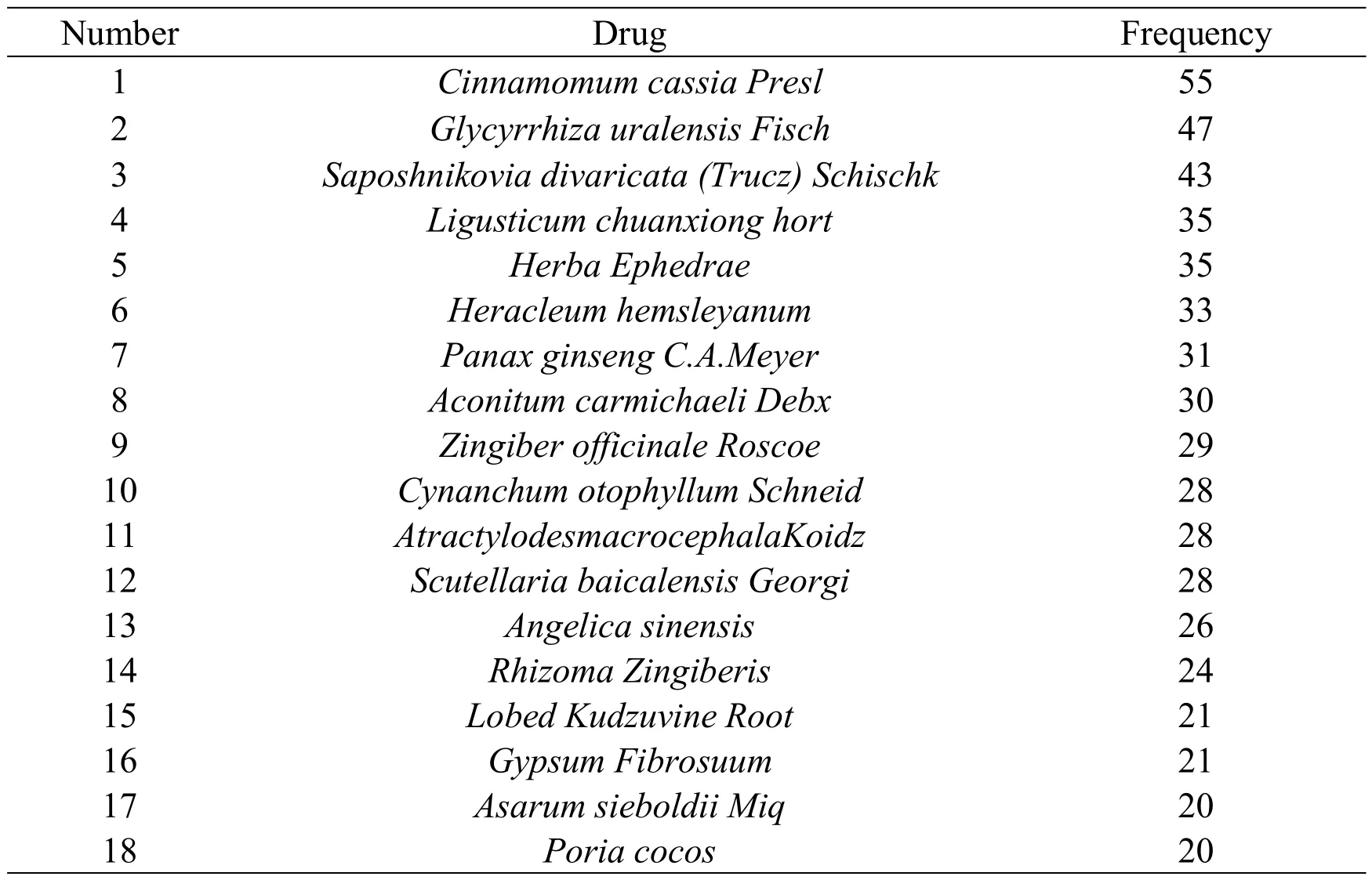
Table3 Drugs with frequency ≥20 in the prescriptions
D.Herbs classification
The herbs were classified according to their syndromes effects in"traditional Chinese Medicine"[4].The results showed that they are mainly deficiency-tonifying drugs,surfacerelieving drugs,and heat-clearing drugs,as detailed in Table 4.
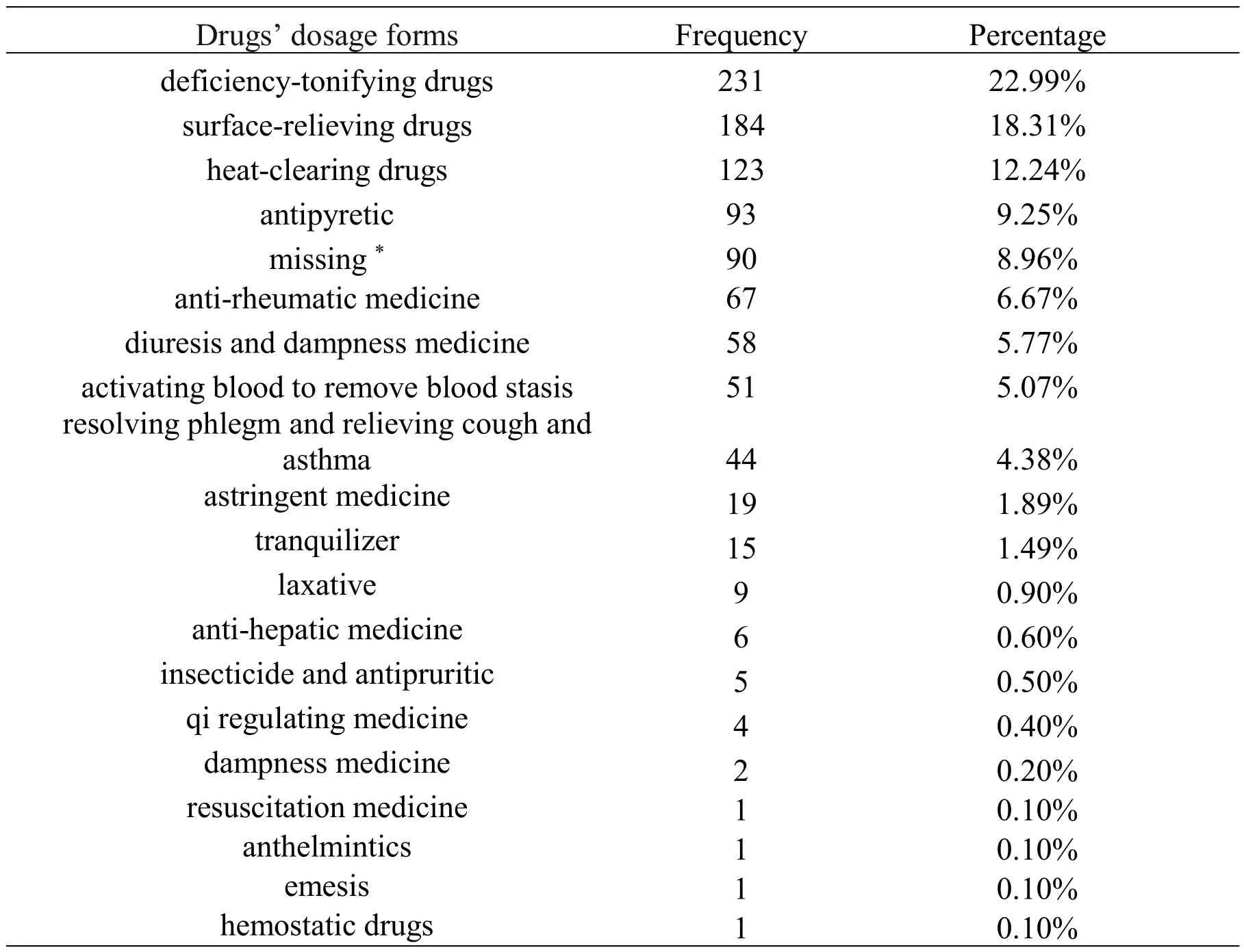
Table4 Distribution of Drugs’dosage forms for cerebral infarction in“Qian Jin Yao Fang”
E.Analysis of four Characters,five flavors and meridian tropism of traditional Chinese Medicine
The four characters,five flavors and meridian tropism were statistically analyzed based on the Great Dictionary of traditional Chinese Medicine (TCM) and the Great Dictionary of traditional Chinese Medicine (Dictionary of traditional Chinese Medicine).Among the 152 drugs,the frequency of warm medicine was the most (448 times).Among the five flavors,the drug frequency of pungent medicine was the most(554 times).In the meridian tropism,the drugs of spleen meridian were the most with 494 times,as shown in Figure 1.
F.Drug compatibility combination and correlation Analysis
There were 10 commonly used drug combinations,and the most frequent drug combinations were "Glycyrrhiza uralensis FischandCinnamomum cassia Presl" with a frequency of 39,followed by "Saposhnikovia divaricata(Trucz)Schischk,Cinnamomum cassia Presl" with a frequency of 36 according to the analysis of association rules(see Table 5).The drug association rules of drug pairs and drug combinations and drug association rules with confidence ≥0.875 were analyzed(see Table 6).Data mining showed that the coprescriptions of"Qian Jin Yao Fang" Cerebral infarction were:Herba Ephedrae,Cinnamomum cassia Presl,Saposhnikovia divaricata(Trucz)Schischk,Glycyrrhiza uralensis Fisch,Ligusticum chuanxiong Hort,Aconitum carmichaeli Debx.The analysis of the prescription rule was shown in Figure 2.
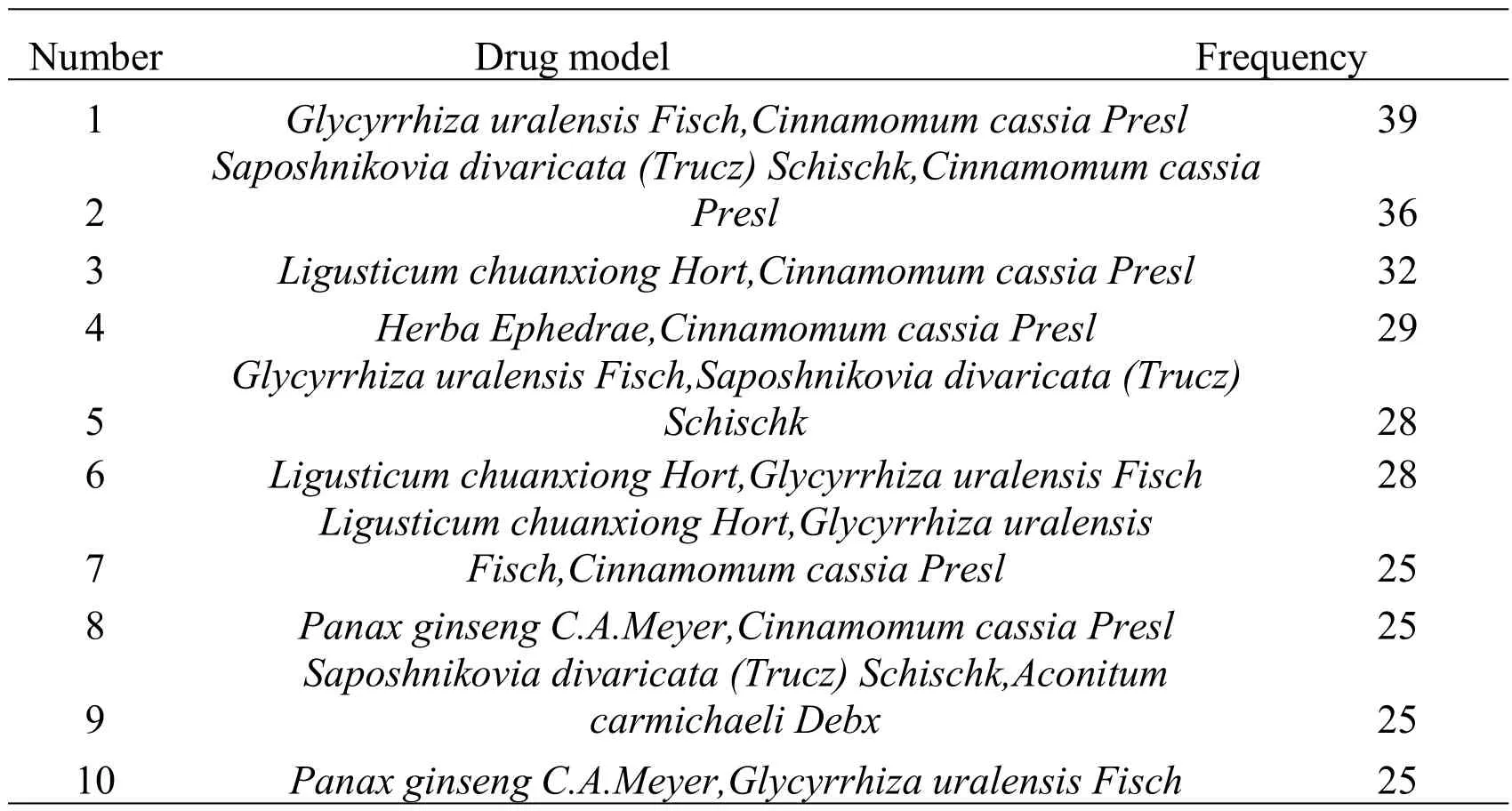
Table5 Drug combination frequency
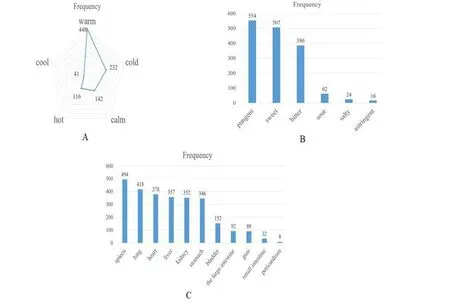
Fig 1 Analysis of four Characters,five flavors and meridian tropism of traditional Chinese Medicine.(A)Analysis of four Characters frequency.(B)Analysis of five flavors frequency.(C)Analysis of the meridian tropism
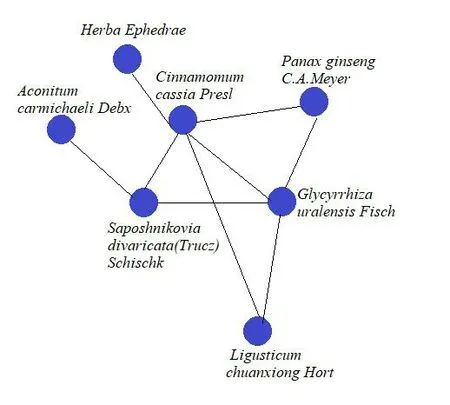
Figure2 Diagram showing the analysis of formulating rules
G.New combination analysis
The drug pairs whose correlation coefficient was more than 0.07 were extracted using the core algorithm of clustering analysis and complex system entropy clustering analysis(Table 7).Based on the core drug combination,four new prescriptions were obtained by using the unsupervised entropy hierarchical clustering algorithm,as shown in Table 8.
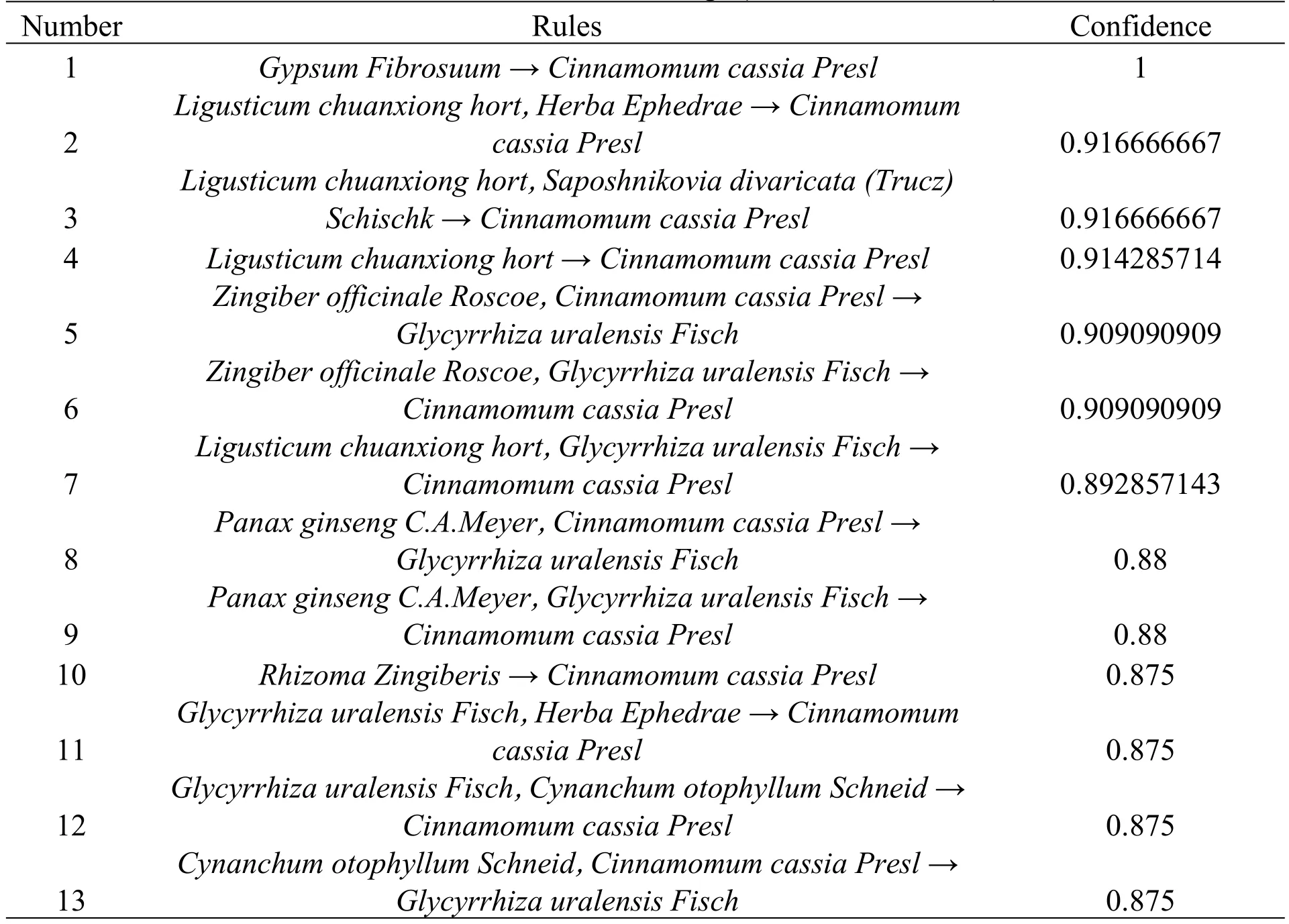
Table 6 Association Rules of Drugs(Confidence ≥0.875)

Table 7 Analysis of drug pair correlation coefficient

Table 8 New prescriptions based on entropy hierarchical clustering
H.Interaction between drugs and disease targets
Map the obtained 246 the core prescriptions targets with 3596 cerebral infarction related targets to obtain 194 intersection targets,which is the potential targets of the core prescriptions in the treatment of cerebral infarction,and draw venn diagram of disease and component targets,as shown in Figure 3.The intersection target were introduced into STRING database to obtain PPI-protein interaction network,which contained 194 nodes with an average local clustering coefficient of 0.36 and aPvalue of <1.0e-16,as shown in Figure 4.
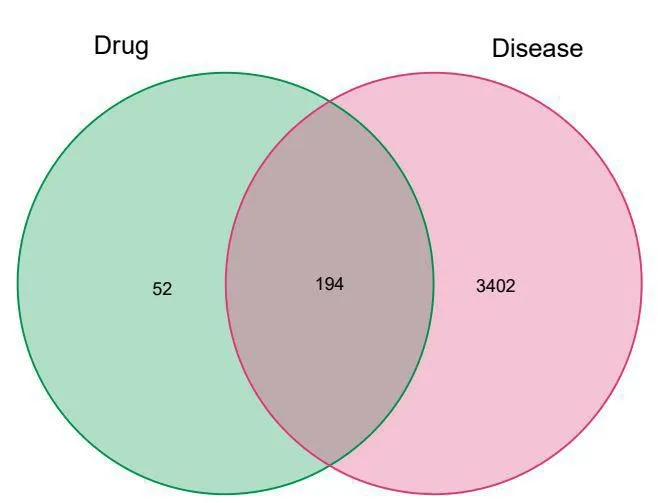
Figure3 Venn diagram of core prescription and disease
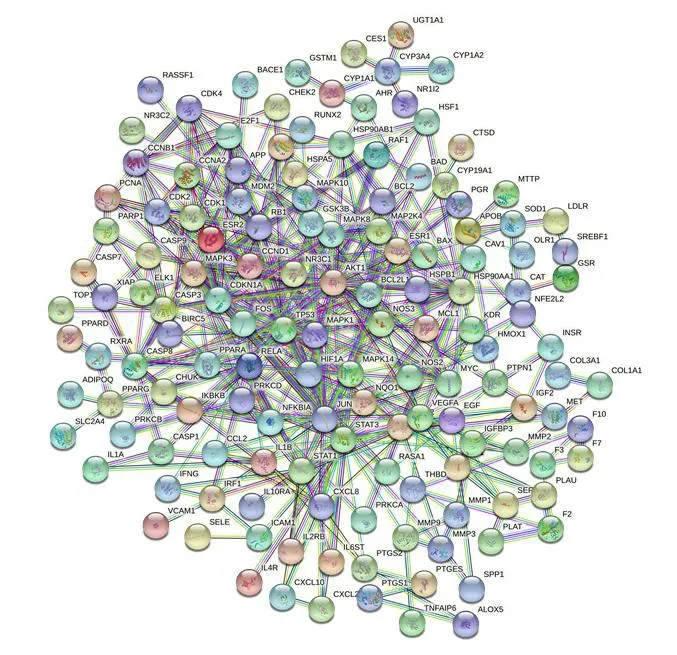
Figure4 Drug-target interaction diagram
I.Path Analysis of related targets
The DAVID database was used to analyze the enrichment of GO biological processes for 45 key targets,withP-vaule<0.05 as the cut-off point.724 GO items were obtained with R software and GO functional enrichment analysis,including 680 biological processes such as steroid response,cell response to chemical stress,response to metal ions and cell response to drugs,and 680 items composed of membrane raft,membrane microstructure domain,membrane region,neuronal cell body,cyst cavity and so on.DNA binding transcription factor binding,ubiquitin-like protein ligase binding,RNA polymerase Ⅱ-specific DNA-binding transcription factor binding,ubiquitin protein ligase binding,phosphatase binding,protein phosphatase binding and other molecular functions were obtained,as shown in Figure5.

Figure5 GO enrichment analysis of core prescription targets
According to KEGG functional enrichment analysis,the pathways of the core prescription in the treatment of cerebral infarction were mainly involved in:PI3K-Akt signal pathway,TNF signal pathway,AGE-RAGE signal pathway,hepatitis B and other signal pathways.It indicated that the active components of the core prescription play a role in the treatment of cerebral infarction through multiple pathways,which indicates that the active components of the core prescription play a role in the treatment of cerebral infarction through multiple pathways(Figure 6).
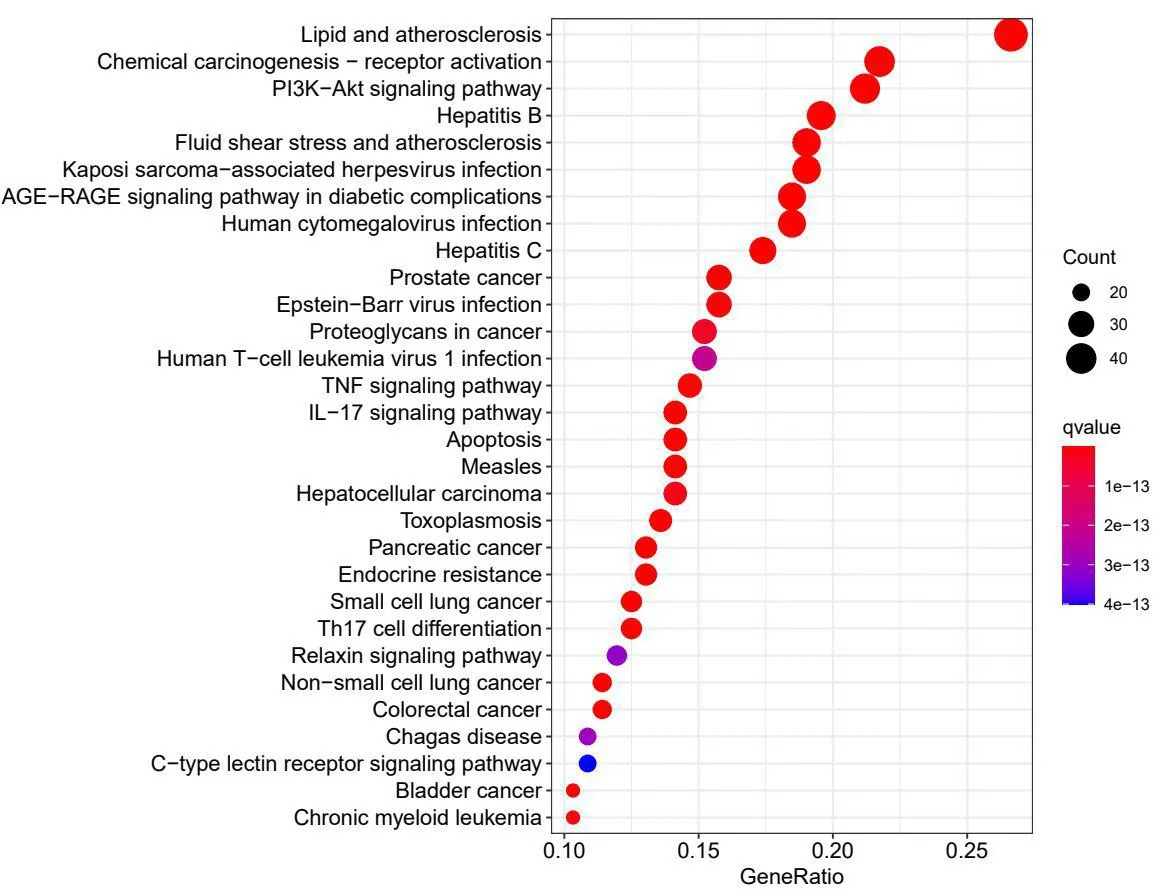
Figure6 KEGG enrichment analysis of core prescription targets
IV.DISCUSSION
Cerebral infarction treatment,the most four characters is warm,and the five flavors are pungent.Cinnamomum cassia Presl,Herba Ephedrae,Saposhnikovia divaricata(Trucz)Schischk,Ligusticum chuanxiong hortand other drugs are all high-frequency drugs,and they are all pungent and warm products in the statistics of drug frequency.Sun Simiao paid great attention to the combined use of dosage forms in cerebral infarction treatment,in which decoction is the main dosage form.In fact,decoction has the advantages of fast absorption and timely efficacy as cerebral infarction frequently occurs rapidly [15].In the meanwhile,Sun Simiao is also good at using alcohol preparation;as alcohol can promote the qi and blood moving,strengthen the absorption of drugs [16].It is emphasized that wind pathogen is an important cause of Cerebral infarction in Chao Yuanfang(Sun Simiao’s Qian Jin Yao Fang Volume 8,and Wang Tao’s Outer Taiwan Secret Essentials).
In the treatment of cerebral infarction,Sun Simiao attached importance to dispelling wind and relieving the surface,and paid great attention to the warmth of organs.The results of data mining show that deficiency-tonifying drugs account for a large proportion in the statistical analysis of drug classification;At the same time,Sun Simiao usually uses warm products such asCinnamomum cassia Presl,Panax ginseng C.A.MeyerandAconitum carmichaeli Debxto tonify the spleen and kidney.Sun Simiao also places great emphasis on warming and tonifying the spleen and kidney.Another example is the four core combinations and four new prescriptions obtained through entropy clustering analysis.Taking prescription one as an example,the prescription is composed ofAconitum carmichaelii,Aconitum carmichaeli Debx,Ligusticum chuanxiong hort,Herba EphedraeandCinnamomum cassia Presl,which could warm liver and kidney,dispell cold and nourish blood,and nourishing,while dispelling wind and relieving surface of Herba Ephedrae,promoting blood circulation and removing blood stasis ofLigusticum chuanxiong Hort,promoting qi and dredging collaterals.
PPI network topology analysis obtained 45 key targets of the core prescriptions in the treatment of cerebral infarction,suggesting that the related mechanism maybe closely related to TP53,STAT3,AKT1,MYC,FOS targets.TP53(Tumor Protein P53) is a Protein Coding gene,it reported that the free radical scavenger edaravone suppresses X-ray-induced apoptosis in MOLT-4 cells by inhibiting p53 [17].STAT3 is a member of the STATprotein family,it suggested thatmelatonin treatment ameliorates brain damage at least partially through shifting microglia phenotype from pro-inflammatory to antiinflammatory polarity in a STAT3-dependent manner [18].Activation of AKT1 has been implicated as a majorcontributor to neuronal survival after an ischemic insult and it reported that numerous neuroprotective agents have been shown to augment Akt activity,suggesting that this protein represents a major mechanism of cellular salvage after injury [19].MYC is a proto-oncogene and encodes a nuclear phosphoprotein that plays a role in cell cycle progression,the current findings provide that SOD1 overexpression attenuates activation ofNFkappaB after transient FCI in mice and that preventing this early activation may block expression of downstream deleterious genes like MYC,thereby reducing ischemic damage [20].FOS (Fos Proto-Oncogene,AP-1 Transcription Factor Subunit)is a Protein Coding gene,it is concluded that TMS has the rapeutic effect on cerebral infarction according to promote the expression of FOS of the cerebral cortex in rats with cerebral infarction.The above analysis indicates that the predicted key targets are important in the development and progression of cerebral infarction.
The GO function enrichment and KEGG signal pathway of Sun Simiao’s core prescription for cerebral infarction were predicted through the pathway analysis of the core prescription of cerebral infarction.As a it was found that its biological function was mainly concentrated in many aspects,such as inflammatory reaction and apoptosis.PI3K-Ak signal pathway is an important signal pathway to promote the survival of nerve cells.Cai Jun et al.[21] confirmed through experiments that the brain protective mechanism of tonifying traditional Chinese medicine on acute cerebral ischemia-reperfusion injury model rats may be related to up-regulating the expression of AKT,p-AKT in PI3K/AKT signal pathway and promoting the phosphorylation of AKT,indicating that traditional Chinese medicine can regulate peripheral inflammatory cytokines.As a consequence,it can reduce brain edema and protect brain tissue.TNF is an important pro-inflammatory cytokine,which has been proved to be closely related to the inflammatory response after cerebral infarction [22].Zhang Juanli et al [23]confirmed that the related components can play a neuroprotective role in cerebral infarction patients by regulating TNF targets to inhibit inflammatory response and apoptosis.AGERAGE signal pathway is also an important signal pathway.Some studies have confirmed that it can promote neuronal recovery through biological processes such as apoptosis and inflammation,and achieve the effect of treatment of cerebral infarction.
V.CONCLUSION
Generally speaking,Sun Simiao’s treatment of cerebral infarction was obtained in order to dispel the wind and relieve the surface,warm and tonify the spleen and kidney through the methods of data mining and network pharmacology.The treatment mechanism may be related to inflammatory reaction and apoptosis,and many signal pathways,such as PI3K-Akt signal pathway,TNF signal pathway,AGE-RAGE signal pathway and so on,can affect it.
Competing interests:
The authors declare no conflicts of interest.
Abbreviations:
TCM,traditional Chinese Medicine;GO,gene ontology.
Citation:
Liu B,Kou ZX.Exploring the regularity of Drug use in "Qian Jin Yao Fang" for cerebral infarction based on data Mining and Network Pharmacology.Drug Comb Ther.2021;3(3):12.doi:10.53388/DCT2021080502.
Executive editor:Na Liu.
Submitted:10 May 2021,Accepted:17 June 2021,On-line:09 July 2021.
©2021 By Authors.Published by TMR Publishing Group Limited.This is an open access article under the CC-BY license(http://creativecommons.org/licenses/BY/4.0/).
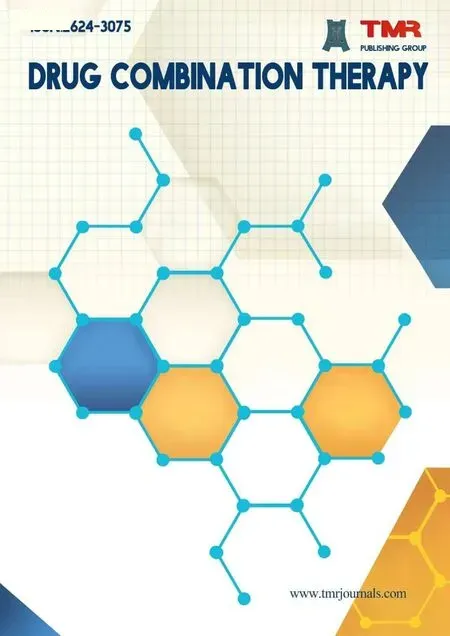 Drug Combination Therapy2021年3期
Drug Combination Therapy2021年3期
- Drug Combination Therapy的其它文章
- Treatment of irritable bowel syndrome with multi-herbal formula:A case report
- The treatment effects of Kaixin Powder on depression through heart-spleen axis
- Potential active compounds and mechanisms of Shen-Qi-Yi-Chang granule for the treatment of colorectal cancer:an analysis of network pharmacology and molecular docking
- Progress of traditional Chinese Medicine on ADHD Treatment Based on Syndrome Differentiation
